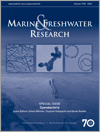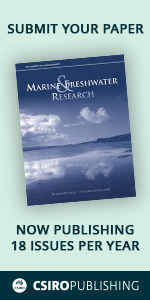
Marine and Freshwater Research
Volume 71 Number 5 2020
Special IssueCyanobacteria
MF18377Monitoring cyanobacteria occurrence in freshwater reservoirs using semi-analytical algorithms and orbital remote sensing
 , Rejane Ennes Cicerelli, Tati de Almeida, Henrique L. Roig and Diogo Olivetti
, Rejane Ennes Cicerelli, Tati de Almeida, Henrique L. Roig and Diogo Olivetti
Cyanobacterial blooms pose a serious risk to human health and the environment in urban reservoirs. Monitoring these events using traditional methods can be expensive and impractical. Using remote sensing technologies, like satellite imagery, can be an effective and inexpensive alternative. In this study we show that concentrations of chlorophyll-a, a cyanobacteria indicator, can be inferred from Sentinel-2 images.
MF18392Mitigating a global expansion of toxic cyanobacterial blooms: confounding effects and challenges posed by climate change
Mitigating global expansion of harmful cyanobacterial blooms is a major challenge. In addition to reducing nutrient inputs and optimising hydrological controls, there is the challenge of addressing effects of climate change, including warming, more extensive droughts and extreme precipitation events. Currently used control approaches will need to be re-evaluated in light of the synergistic effects of climate change with nutrient enrichment.
MF18429Hyperspectral remote sensing monitoring of cyanobacteria blooms in a large South American reservoir: high- and medium-spatial resolution satellite algorithm simulation
Remote sensing constitutes a tool to complement field monitoring of massive growths of cyanobacteria (blooms). In a South American reservoir with recurrent blooms, we obtained 75 hyperspectral signatures in the field under conditions of cyanobacteria dominance. We used the field signatures to simulate signatures in seven satellites, and developed mathematical formulas (algorithms) for each satellite to estimate the number of cyanobacterial cells in the field.
MF18383Pilot application of drone observations and pigment marker detection by HPLC in studies of cyanobacterial harmful algal blooms in Bulgarian inland waters
This paper describes the first attempt to use a drone and marker pigments for fast determination of phytoplankton in harmful cyanobacterial bloom studies in selected Bulgarian shallow waterbodies. Microcystins, saxitoxins and cylindrospermopsin were detected in samples with the highest cyanobacterial content. Further use of drones and marker pigments in the monitoring of harmful algal blooms is recommended.
Little is known about the response of soil microbes to changing inundation frequency in floodplain wetlands. This issue was investigated in the Macquarie Marshes, south-east Australia. We found significant differences in response among soil microbes, including Cyanobacteria. Changing inundation frequency is likely to affect wetland soil health and microbial diversity by altering the subtle balance of microbial communities.
MF18376Drivers of cyanobacterial blooms in lakes and reservoirs in Jinan City, China
Understanding how topography and human activities affect cyanobacterial dominance and blooms can effectively protect water ecological health. Based on the dominant species in the cyanobacteria community, key driving environmental factors were identified. Further spatial classification found topography and human activities were highly correlated with the key driving factors. The results can provide references for cyanobacterial bloom prevention across the world.
Food web network interactions among micro-organisms induce or inhibit blooms. This paper reviews interactions between cyanobacteria, zooplankton and other micro-organisms, because these biotic interactions are not well recognised. The paper describes new areas of research, the results of which provide us with a better understanding of the processes of proliferation, migration and invasion of cyanobacteria.
MF18361Dynamics of nitrogen-fixing cyanobacteria with heterocysts: a stoichiometric model
Cyanobacteria can cause water quality problems through excessive biomass and the production of toxins. Their ability to become abundant is aided by specialised cells (heterocysts) that obtain nitrogen from the atmosphere. A simulation model describes the dynamics of these specialised cells, of biomass and of the nutrients nitrogen and phosphorus. This model can be used to aid predictions of cyanobacterial biomass and toxins.
MF18432Survey of microcystins in Singapore's reservoirs using liquid chromatography–tandem mass spectrometry (LC-MS/MS)
Microcystins (MCs) are a group of toxins produced by certain cyanobacteria that occur naturally in fresh waters and can cause acute poisoning in humans and animals. A comprehensive survey was undertaken over a 12-month period in 17 reservoirs from November 2012 to October 2013 and determined that toxin levels were primarily well below the WHO provisional MC-LR drinking water guideline.
MF19157Sample extraction and liquid chromatography–tandem mass spectrometry (LC-MS/MS) method development and validation for the quantitative detection of cyanobacterial hepatotoxins and neurotoxins in Singapore's reservoirs
Cyanobacterial ‘blue–green algal’ toxins are produced by some harmful algal blooms (HABs). To investigate the prevalence of cylindrospermopsin (CYN) and anatoxin-a (ANA) in Singapore’s reservoirs, a hazard analysis was initiated to profile the CYN and ANA levels present. The dominant cyanobacteria genera during that 12-month period (November 2012–2013) were Cylindrospermopsis, Planktolyngbya, Pseudanabaena and Microcystis.
MF18373Global scanning of anatoxins in aquatic systems: environment and health hazards, and research needs
Cyanobacteria can undergo rapid proliferation and lead to hazardous environmental conditions, including the production of toxins. Anatoxin-a and its analogues are cyanobacterial neurotoxins that have been found globally. This study examined their occurrence in various surface waterbody types and organisms around the world and associated aquatic toxicity, and identified research needs for understanding exposure conditions and risks for wildlife and humans.
MF18406Distribution and conservation of known secondary metabolite biosynthesis gene clusters in the genomes of geographically diverse Microcystis aeruginosa strains
The cyanobacterium Microcystis aeruginosa produces the liver toxin microcystins, as well as a variety of other potentially harmful compounds. This study identified genes associated with the production of nine different compounds spanning four chemical classes in 27 strains. The results highlight the potential chemical diversity within this species and will be valuable for designing holistic genetic tests for water quality.
MF18406 Abstract | MF18406 Full Text | MF18406PDF (519 KB) | MF18406Supplementary Material (362 KB) Open Access Article
MF18381Monitoring of cyanobacteria for water quality: doing the necessary right or wrong?
Cyanobacteria are an influential and widely acknowledged biological component of lake water quality assessment. Nevertheless, there are gaps in the monitoring of cyanobacteria. In this article we review widespread problems in the use of cyanobacteria in Water Framework Directive-related water quality assessment (i.e. exclusion of taxa, mucilage carbon of the colonial species, sampling depth) and suggest solutions to optimise water quality assessment.



